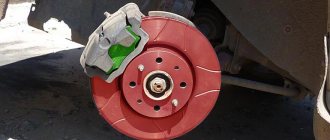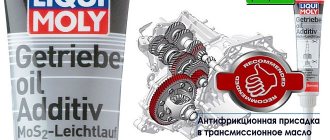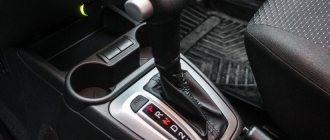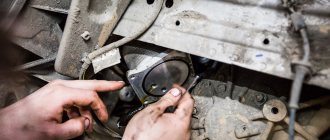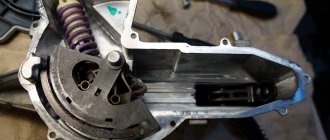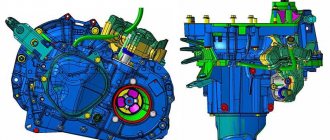The automatic transmission is a much more popular type of transmission today for a number of reasons. First of all, this type of gearbox greatly simplifies the process of driving a car, driving becomes more comfortable and safe, since the driver is not distracted by changing gears, errors when choosing a gear, etc. are eliminated.
At the same time, it is also well known that an automatic transmission is a complex and “capricious” unit compared to a manual transmission. Naturally, the more complex the device, the greater the likelihood of serious breakdowns.
However, in practice it often happens that one driver’s reliable manual transmission fails earlier than another’s automatic transmission. In this article we will talk about the service life of the automatic transmission, as well as what factors and features directly affect the service life of the automatic transmission.
Automatic transmission resource: automatic transmission, robot and CVT variator
So, today there are several types of automatic transmissions: classic hydromechanical automatic, CVT or robot. Although robotic transmissions have recently somewhat displaced conventional automatic transmissions, automatic transmission remains the most common option.
Let's move on. Given that there are several types of automatic transmissions, it would be a mistake to think that all automatic transmissions are unreliable. The fact is that, for example, a robotic gearbox is radically different from a CVT or automatic transmission, CVT cannot be compared with DSG, etc.
In other words, the resource of one type of machine can be very different from another. Suffice it to recall the old 4-speed automatic transmissions with a torque converter, some of which are considered to be the most reliable automatic transmissions in history.
These checkpoints could easily cover 500 thousand km. and more without any repairs. If we talk about cheap single-disc robots such as AMT, problems with the transmission and its elements on a new car can arise as early as 40-50 thousand km.
- Robot box. Today, this type of automatic transmission is actively used by many automakers, while manual transmissions with one clutch (single-disc robot) have actively taken root in the budget segment.
To put it simply, this is ordinary mechanics, but the clutch operation, gear selection and shifting are controlled automatically using servomechanisms. The gearbox itself is reliable, however, problems often arise with the specified servomechanisms (actuators) and clutch.
The clutch often fails at 50-80 thousand km. mileage, actuators are also often irreparable, that is, they need to be replaced entirely. Taking into account the high cost of servos and the short service life, it turns out to be unreliable and not at all budget-friendly. In other words, such a robot has the lowest resource among all machines.
Another type of manual transmission is
preselective gearboxes
with two clutches, well known to ordinary car enthusiasts from the Volkswagen concern and the DSG gearbox. Such boxes are more reliable than single-disk robots, however, problems with them also arise, on average, at 100-150 thousand km. mileage Clutch discs wear out and actuators fail.
To extend the life of a box of this type, you need to remember about software updates, undergo diagnostics, the box needs to be constantly “trained,” adapted, etc. at the slightest deviations and malfunctions.
If we are talking about a new car that comes under warranty, then up to 100 thousand you don’t have to worry too much about the service life of the robotic automatic transmission, but then problems with the robot can cause a significant blow to the owner’s pocket.
- CVT variator. This transmission is often installed on middle and high-class cars, both passenger cars and crossovers. The advantage of the variator is the stepless change of torque, which ensures a high level of comfort and smooth operation.
At the same time, the resource and reliability of the variator directly depends on driving style and quality of service. First of all, the variator is sensitive to the quality and level of oil in the box, is not designed for high torque, and is afraid of sharply changing loads. In a car with such a gearbox, it is undesirable to actively start from a standstill, skid, or use the car for off-road driving, towing a trailer or other vehicles.
Also, during operation, the variator belt must be changed every 100 thousand km, since its rupture can cause complete failure of the gearbox. It should also be noted the low maintainability and high cost of high-quality repair of the variator, the need to frequently change the oil filter and oil (it is advisable to replace it every 30-40 thousand km).
At the same time, strict compliance with all regulations and recommendations regarding the maintenance and operation of the variator allows you to increase the service life to 200 thousand km (taking into account regular changes of the oil and variator belt). Otherwise, the variator may require repair by 120-150 thousand km.
- Hydromechanical automatic. If we talk about the resource, this type of gearbox, with proper maintenance and competent operation, has a fairly long service life.
Compared to analogues, a simple automatic transmission clearly wins in this regard, and by a large margin. The design is time-tested, the box can withstand high torque, there are no servomechanisms or a quickly wearing clutch.
In practice, there are far from isolated cases when a torque converter machine lasted 200-250 thousand km. even without changing the automatic transmission oil and filter. The only thing is that this statement is more true for simple and reliable boxes that were produced back in the 90s.
We also recommend reading the article about
which automatic transmissions are the most reliable
. From this article you will learn about automatic transmission models that are considered “indestructible” and can travel about 500 thousand km. and more without repair.
Today, automatic transmissions have become more technologically advanced and complex, the load on the transmission has also increased, and the requirements for oil quality and its properties have increased significantly. Also, the automakers themselves, in order to reduce the cost of production and for a number of other reasons, stopped producing units that have a large margin of safety (clutches have become “paper”, hydraulic units are reduced in size, automatic transmission cooling has deteriorated, and often there is simply no dipstick for checking the oil level in the machine).
However, timely maintenance, even in this case, still allows you to increase the service life of many modern automatic transmissions to about 250-300 thousand km. In order for the automatic transmission to serve for a long time, it is necessary to completely change the oil and oil filter in the automatic transmission every 50 thousand km,
use only those oils that are recommended by the car or gearbox manufacturer itself
, flush the automatic transmission cooling radiator, install an additional one if necessary.
Also, during operation, you need to constantly monitor the oil level in the automatic transmission and its condition, prevent overheating of the automatic transmission, avoid stress on the transmission, drive the car in a gentle mode, without active acceleration, slipping, etc. In this case, it is quite possible to travel about 300 thousand km. without automatic transmission repair.
About the producers' conspiracy
Car owners like to say that manufacturers deliberately reduce the service life of automatic transmissions at the factory. Today they no longer produce automatic transmissions that can operate a million kilometers without major repairs. To this must be added the temperature changes in Russia from -40 to +40, as well as the love of car owners for fast driving and cold starts even in winter. Therefore, if in Japan Toyota automatic transmissions are given a service life of 7 years, then on roads in the Russian Federation this period can be cut by exactly half, if not more.
It’s another matter when the manufacturer assures the client that the automatic transmission can be operated without changing the lubricant in it. In fact, no - it's just a marketing ploy. For Volkswagen's DSG gearbox, it is recommended to change the oil every 30,000 kilometers.
All fables about the conspiracy of manufacturers can be avoided if you look into the automatic transmission more often and change the oil and components on time. And proper operation will allow you to extend its life for years.
Reliability and service life of classic automatic transmission
From the previous sentence about a robotic automatic machine, we can already conclude that the service life of a classic automatic transmission will be longer. If only because it does not require frequent replacement of transmission fluid. This suggests that its mechanical components are more reliable.
Read
Reviews on the operation and repair of an automatic transmission on a Chevrolet Lacetti
Attention! An oil change should be done after 60,000, 70,000 kilometers.
If we compare automatic transmission, robot and variator, then neither of the last two can produce as much as the automatic transmission does. The automatic transmission is the standard of reliability. Since it does not have complex mechanical components.
The mechanical clutch function here is performed by the automatic transmission torque converter. Torque from the engine is transmitted to it via ATF.
The oil circulates in the valve body and is distributed through the channels, affecting the actuators or clutches. By applying oil pressure to the clutches, gears are changed. But, recently, clutches began to be produced with an admixture of plastic. This reduced the lifespan of the clutches.
With timely replacement of the oil filter and cleaning of the radiator, the automatic transmission will last a long time. The torque converter is sensitive to the lubricant level. Therefore, it is recommended to monitor the oil level.
Read
Technical characteristics of automatic transmissions, types and their differences from each other
The following actions increase the lifespan of an automatic transmission to 500,000 kilometers:
- warming up the machine in winter;
- avoiding slipping on off-road conditions;
- correct towing of a car in case of breakdown.
CVT gearbox and resource of this machine
The CVT transmission (or variator) is the second most reliable. The main difference from automatic transmission is the absence of fixed gear shift stages. But the CVT still uses a torque converter, just like the previous one.
The variator consists of two shafts with pulleys, on which a belt or metal chain is worn. Gear shifting occurs by changing the distance between the pulleys depending on the load on the vehicle. Due to the constant change in the gear ratio, the conditional gears change.
The car owner does not feel constant jerking and jerking when changing gears. Therefore, this box is chosen by those who love a comfortable ride. But the question is how long it lasts.
The service life of the variator is forty percent lower than that of a classic type automatic transmission. It's all about the appearance of chips and dirt in the oil from wearing metal parts. They act on the belt and pulley like an abrasive tool, abrading the surface. As a result, the belt must be changed after driving a car with a CVT for 90,000 kilometers.
Robotic box and its resource
The robotic transmission has a low resource. Since the robot was essentially supposed to become an automated manual transmission. Such a box should have received all the conveniences of an automatic transmission and be as simple as a manual transmission. But this did not happen due to the addition of servomechanisms and an additional clutch unit.
Read
Reliability of automatic transmission of Niva Chevrolet: maintenance and malfunctions of the machine
There are two types of robot:
- AMT.
- DSG.
AMT
Automated mechanics are servos and actuators that are responsible for shifting gears and clutches. The servo drive is responsible for the latter. He is the unfavorable part of the robot. Before giving a signal to change the gear, the drive must be guided by sensors based on engine speed, temperature and speed.
The relationship between them is not established from the factory. In terms of comfort it is inferior even to an automatic. The car owner constantly feels jolts and jerks when changing gears.
DSG
If AMT is a single-disk robot, then DSG consists of two disks. Volkswagen's DSG belongs to this type. One disk is responsible for even transmissions, the other for odd ones. This type of robot was released to reduce the same shocks and jerks that could not be avoided with the release of the AMT.
Cars with this type of automatic transmission are distinguished by their efficiency, travel comfort, and smooth acceleration. But in terms of lifespan, they are inferior even to a CVT. This type of automatic transmission is enough for 100,000 km. Then the disks and mechatronics (a kind of valve body in the DSG) start to break down, and the software starts to glitch.
Service life of modern transmissions: how long does an automatic transmission last before repair?
When designing a modern automobile industry, a service life of 300,000 km is calculated for each model, sometimes a little less. The era of engines and transmissions of “millionaires” ended with the tightening of environmental regulations for vehicles, as well as due to the increase in the power of power equipment.
Modern multi-stage hydromechanical automatic transmissions are developed with a safety margin of up to 250-300,000 km, preselective robots - up to 150,000, CVTs - up to 200,000 and depending on the load level. In particular cases, automatic transmissions can work out both longer and shorter service life - the service life is largely influenced by the timeliness and quality of maintenance, as well as the driving style of the car owner.
Overhauling the transmission can restore its operational potential by approximately 80%. Properly restored gearboxes after repair can last another 120-180,000 km. However, this is true when components that have exhausted their service life are completely replaced, the transmission is fully diagnosed for hidden defects, and certified maintenance consumables are used.
Important! To maximize the service life of the automatic transmission, it is important to adhere to the maintenance and operation regulations. In particular, it is necessary to completely replace the transmission fluid at least every 50-60,000 km, monitor the temperature of the transmission and contact the service for diagnostics immediately after the first signs of a malfunction appear.
Volkswagen Tiguan
The reason for the popularity of this brand is its excellent design, solid and at the same time original, good driving performance, spacious interior, spacious trunk and electronic systems inside.
Many experts believe that the Tiguan is a kind of pinnacle of the evolution of class B crossovers. There are two engines to choose from - 1.4 liters and 2.0 liters with a volume of 150 and 180 “horses”, respectively. There are configurations with all-wheel drive and even a special option for the Russian winter - the so-called. Winter Edition with heated seats, snow and ice distance control, three-zone climate control and even a rain sensor. Apparently, the compilers of the package are familiar with Moscow winters firsthand.
What factors affect the service life of an automatic transmission?
The durability of the gearbox depends on timely and competent maintenance. It is necessary, in accordance with the recommendations of the car manufacturer, to change the oil and regularly monitor the condition of the radiator and oil receiver. Proper operation of the automatic transmission implies proper warming up of the working fluids before starting the vehicle. That is why in the winter season you need to pre-heat the box, which takes one or two minutes. This is the only way you can ensure maximum durability of the automatic transmission, and not wonder how long the automatic transmission runs .
Car manufacturers equip their models with both automatic transmissions of their own design and install them under license from the world's leading transmission manufacturers. That is why, when choosing a particular model, it would be useful to read reviews from owners about the reliability of a particular gearbox design. Determine the gearbox installed in your car.
Reliability of Toyota automatic transmission | Myth or reality?
Automatic transmissions from the Toyota manufacturer have proven themselves to be the best. The relatively simple design is combined with durability and excellent maintainability. The service life of a Toyota automatic transmission can be about half a million kilometers. On average, automatic transmissions currently have a mileage of 200–300 thousand kilometers. After this, it is necessary to carry out a major overhaul of the transmission, which allows you to restore its functionality.
Toyota RAV4
Both the Toyota Camry business sedan (seventh place in the ranking) and the Toyota RAV4 crossover are the two most popular cars from Toyota with automatic transmission, they alone account for more than 60% of sales.
The Toyota RAV4 (fourth generation) was generally the leader among Russian crossovers for several years, but now it has been supplanted by the KIA Sportage and Volkswagen Tiguan. Experts say that the reason is simple - the rise in price of Toyota. However, at the end of last year a new, improved model entered the Russian market, which seems to have increased the rating of the Toyota RAV4, at least among owners of an automatic transmission.
Currently, the fifth generation on the Russian market has a 2.0 or 2.5 liter engine, two transmissions - a CVT or an eight-speed hydromechanical - and two drive options (they differ in the number of clutches in the rear wheel drive).
How can you tell if the box is faulty?
Symptoms of a faulty automatic transmission include the following:
- Lack of oil on the dipstick or rapid oil consumption.
- Black oil, burning smell, metal or other debris, debris in oil.
- Kicks, dragging, jerking when changing gears.
- One or more transmissions are missing.
- The box “howls”, makes noise, crackles, knocks, clanging, and grinding noises are heard.
- Gears are not engaged when changing the gear selector position.
- When the gear is active, the car does not move, nothing happens when changing gears, or the engine is running, but the car is standing still.
- When starting to move or at speed, the car stalls.
- The automatic transmission fault indicator light is on.
- The automatic transmission sometimes behaves strangely, sometimes completely normally, the symptoms of a breakdown are sometimes present, sometimes they are not.
- Oil leaks are visible on the automatic transmission housing or in the parking area.
- Acceleration performance or vehicle dynamics have dropped.
- When driving in reverse or forward, the car starts moving only when you press the gas; there is no driving effect when the clutch is released.
After a machine breakdown, the car owner should immediately send the car for diagnostics. Then there are usually four options:
- Option one - repair
Depending on the automatic transmission model and the nature of the damage, the price of repairs can vary - from several thousand rubles to hundreds of thousands. Automatic transmission repair at a certified service station is a very good option. At the end of the day, the owner in most cases receives a practically new box. But repairs are not always possible or practical. If the valve body of a six-speed gearbox has been destroyed by dirty oil, restoring it will cost more than even buying a new one.
Repairs must be carried out by a professional. An inexperienced and inept mechanic is unlikely to be able to do everything right. Poor repairs can extend the life of the box by only a few months, or even days. Therefore, it is very important to take a responsible approach to choosing a service where repairs will be carried out. It is better to order spare parts yourself, it will cost less, and it will also increase your confidence that the service station will not deceive you and will not install cheap analogues.
- Option two - new box
Boxes cost different things for different cars. The price of a new automatic transmission can shock even a wealthy owner of an expensive premium car, especially in an economic crisis. Traditionally, it, along with the engine, makes up a significant part of the price of the car. After three years of operation, a Peugeot class car will greatly fall in price, and a new gearbox for it can be a third, or even half, of the cost of this used car. And given the reliability of Peugeot units, a new automatic transmission may be needed in just 2-3 years.
- Option three - contract box
The contract machine was removed from a used car. In most cases, this is not a bad option at all. The box usually arrives with relatively low mileage, is not tired and has only seen foreign service. Or things could have gone wrong. And the former owner was drifting on it. Or the former owner saved money and never changed the oil, but the engine died first.
In general, the contract box is a pig in a poke. For older popular cars, however, this is an excellent option. For example, for a Toyota Mark2 in a 90 body, a working automatic transmission can be found at a price of 5,000 rubles, while repairs will cost 5-6 times the amount. The warranty on contract automatic transmissions usually does not exceed twenty days. For example, a Toyota A340 automatic transmission, which has been running for 20 years, can be supplied with a contract one - most likely, the previous owner managed to kill the car, but not the transmission, it simply outlived the car.
It makes sense to order some automatic transmissions already with a “history”. For example, the AL-4 automatic transmission has a lot of technical defects straight from the factory, which are usually corrected at a service station during the first major repair. The contract AL-4 can come immediately with a replaced heat exchanger and an installed radiator, fan, sensor, with a remote main filter, etc.
- Option four - automatic transmission after restoration
The automatic transmission that was subject to restoration is essentially a new automatic transmission. All broken parts were replaced with new ones, and it was subject to washing and cleaning. Its restoration was carried out by trained specialists, they carried out diagnostics, repairs and adjustments, if necessary. The quality of the restoration, of course, depends on who made it and where. The automatic transmission can be repaired by the manufacturer or in a dubious garage somewhere in Belarus or the Baltic countries.
When restoring, torque converters are usually repaired, all gaskets, oil seals, sealing and rubber elements are changed, the valve body is washed and cleaned, solenoids and clutch packs are replaced, the filter is changed, new oil is added, and sometimes bolted connections can be replaced.
Kia Spectra II
The second generation of Kia Spectra was produced from 2004 to 2008. Now they are asking 207 thousand rubles for it on average.
Officially in our country, one engine option was offered with an automatic transmission - 1.6 liters with a capacity of 101 hp. With. The transmission on the Spectrum is the same as that on the Accent, but the performance properties of the transmissions manifest themselves differently. Among the widespread negative reviews of the Spectra automatic transmission is the periodic appearance of vibration and jerking when switching. Planetary gears often howl and clutches wear out. Also, the automatic machine does not tolerate overloads, for example, when towing or using super-heavy trailers.
The Spectra's equipment is at the level of other models in the rating: driver's airbag, electric windows, air conditioning, heated seats and mirrors.
The model is old, so most of the “Spectrum” are sold with a duplicate title, after an accident, with an estimate of repair work and a twisted mileage.
There are models with unpaid fines and a taxi driver's past:
The chance of buying a problem-free car is high. Every third Kia Spectra is sold as “clean”.
Where is the automatic transmission oil dipstick located?
In order to find out exactly where the automatic transmission oil dipstick is located, refer to your car's manual, which necessarily contains information about the location of the transmission oil dipstick. As a rule, such information is located in the “Car Maintenance” section.
Ten cheap solutions for car tuning
Here are some examples in the form of photographs in which we have marked with an orange arrow the location of the transmission oil dipstick in various cars:
When is automatic transmission diagnostics and repair needed?
If you have any problems with the gearbox related to oil leakage, extraneous noise, difficulties with shifting the automatic transmission handle, shock during automatic gear changes, slipping, etc., then it’s time to diagnose the automatic transmission.
Your task is to recognize a gearbox malfunction in time and carry out diagnostics as soon as possible. This needs to be done as quickly as possible before possible minor problems with the transmission become global.
Remember that once problems with an automatic transmission appear, they will not go away. So don’t expect that oddities in automatic transmission operation will disappear over time.
Contact a specialized car service center or a dealer technical center to diagnose the automatic transmission. Do not forget to inform the technician about all signs of malfunction, describing in detail how the transmission works.
If a fault is found in your automatic transmission, then most likely it is time to repair it. Don't be alarmed. You will not need to purchase a new transmission. In most cases, an automatic transmission can be repaired. We advise you to carry out repairs only in those places where you will be given a guarantee for the restored automatic transmission.
How to check the serviceability of the automatic transmission during the initial inspection
Low mileage of an automatic transmission is not always the key to the health of a car when purchasing. There are cunning people who skillfully throw it off.
Therefore, you need to pay attention to the following signs:
- ATF level and quality;
- behavior of the vehicle when traveling.
Attention! When buying a car, you need to drive it for 15 kilometers to feel the behavior of the automatic transmission. Many errors only come out when the box is warmed up.
Checking the level and condition of the oil in the automatic transmission
Before buying a car, you need to check the oil level in the automatic transmission.
This is done as follows:
- Start the vehicle engine.
- Warm it up by letting it run for 10 minutes or driving the car 10 kilometers.
- Stop on a flat surface.
- Unscrew the dipstick and look at the HOT mark.
- The liquid level should reach this mark. If less, then it is possible that the torque converter has not received additional lubricant for a long time.
Along with the level, it is recommended to pay attention to the color. If the ATF fluid is black or dark in color mixed with small wear particles, then the vehicle has definitely not been maintained. This means that the automatic transmission can break down at any time after purchase.
Attention! It is recommended to use original replacement oil.
Now the car owner must decide whether to buy a car or not. After all, you will have to change not only the ATF fluid in the machine and the filter, but also possibly some internal parts.
To ensure the integrity of the automatic transmission, it must be checked while driving.
Assessing the quality of automatic transmission while driving
To check the quality of the automatic transmission, you need to drive the vehicle for about 15 kilometers. Since usually all automatic transmission errors appear only when the device is warm.
If the car jerks when changing gears, the car owner hears knocks or feels jolts while the automatic transmission is operating, then such a device requires major repairs.
Main automatic transmission breakdowns and ways to fix them
Whatever the automatic transmission, it is a technically complex unit, and it is capable of failure. The main “diseases” of Aisin boxes:
The car slips after it warms up, while the “cold” car drives normally.
This is caused by a number of reasons. One of them is a lack of oil in the box. While the car is cold, the oil has increased viscosity and density, the fluid pressure is enough to ensure normal movement. After warming up, the oil becomes more liquid, the pressure decreases, the transmission begins to “glitch”, and the car slips.
In this case, you should simply add gear oil to the Aisin gearbox to the required level.
The second possible reason is contaminated oil. Foreign elements gradually clog the box filter, and the pressure in the system decreases. To solve this problem, you will have to replace the fluid along with the filter.
The third reason is the combustion of the friction disc block.
You should remove the transmission pan, inspect the discs and piston seals, replacing them if necessary.
The box makes extraneous noise, the car does not move, or barely moves, until the oil warms up.
The main reason for this is the failure of the gearbox torque converter. The problem can only be solved by replacing the broken unit.
The car barely moves forward and does not respond to reverse gear. If you try to push the car back, you won't be able to do it.
Such symptoms indicate a breakdown of the planetary gearbox when the sun gear jams. The way to fix the problem is to replace the failed parts or repair them.
The forward gears on the box are engaged, but the reverse gears are not.
Most likely, the brake band of the box is broken and needs to be replaced.
For six-speed gearboxes: 6th gear and reverse are not engaged.
Clutch friction discs are worn. Parts should be replaced.
The transmission gear ratio changes only in the range of 3-5 thousand revolutions, and above.
This behavior is caused by a decrease in oil pressure in the system due to wear on the gearbox gears.
The car has lost its dynamics, the oil pressure in the box is reduced.
This may mean that the box filter is clogged with metal dust from automatic transmission components. The filter and possibly the oil pump should be replaced, since clogging occurs with particles from its gears.
Noise from the automatic transmission at idle.
This means that the automatic transmission torque converter blades are rattling or the discs on the transmission input shaft coupling are worn to the limit. The corresponding units need to be repaired or replaced.
The transmission hit a hard surface, after which the car stopped starting.
You should try to put the box back in its original place if it has moved. If the operation is unsuccessful, you need to adjust the gearbox control rod.
The P position on the box selector is not set.
It is necessary to adjust the automatic transmission drive, diagnose and repair the gearbox locking device.
No transmission brake.
The transmission brake needs to be repaired and the block crown pawl needs to be replaced.
After turning on N on the gearbox selector, the car moves.
The running discs are probably burnt out, or the automatic transmission drive has gone wrong. The box drive should be adjusted or the discs replaced.
The box slips on inclines.
As a rule, this indicates a low oil level; the symptom is eliminated by topping it up.
There is oil on the torque converter housing.
Most likely, the oil pump seal has leaked and should be replaced.
If you don't press the gas, the car rolls back on the slope.
The freewheel is worn out and the part needs to be replaced.
BMW automatic transmission
BMW has fairly reliable gearboxes, but they have their own resource. The cost of new or contract BMW automatic transmissions is very high. Spare parts are also expensive, but in general, a restored BMW gearbox will be cheaper. Considering the class of the car, such boxes are usually given a guarantee of 100,000 kilometers, which is not bad at all.
Removing scratches on a car body without painting.
DON'T WASTE MONEY ON REPAINTING! Now you can remove any scratch from the body of your car in just 5 seconds.
Read more >>
Crossovers - description, advantages and disadvantages
The name comes from the term crossover utility vehicle (also CUV). This means an all-terrain vehicle that combines the main advantages of cars of other classes:
- off-road vehicles (SUV) - cross-country ability, rigid load-bearing body, equipment;
- family cars - spaciousness (including trunk) and comfort;
- urban models - compactness, often relatively low cost.
Representatives of the crossover class are often based on the platform of conventional passenger cars. Geometric cross-country ability, high suspension and sometimes a protective coating on the bottom are “added” to the body. The equipment of such cars usually includes all-wheel drive, automatic transmission, auxiliary road functions and other components.
The vast majority of crossovers are not designed for serious off-road driving. Basically, they are needed in order to safely and conveniently move around the city and highways, sometimes going onto dirt roads, for example, to the country or on vacation.
Advantages of crossovers:
- All-wheel drive available on most models. Of course, this parameter is not the same as that of full-size SUVs, but it greatly helps to overcome difficult sections of the road - from curbs and road defects to obstacles in rough terrain. As a rule, all-wheel drive is activated automatically (if necessary) or at the request of the driver - it is usually not permanent. The benefit of such a system is significant fuel savings in the city and on the highway.
- High driving position. Helps you see the road better, which increases safety and the chance to react to an obstacle. Visibility improves control.
- High ground clearance. Compared to city cars, the ground clearance of crossovers is relatively high. Sometimes the distance to the bottom can be compared to that of SUVs. With this characteristic it is easier to overcome obstacles.
- Geometric cross-country ability. This is a special structure of the body when it does not touch obstacles when the crossover is in a non-horizontal position - pulling out or going uphill, as well as roll.
- Confidence when moving. The attributes of most crossovers - automatic transmission, all-wheel drive, stable heavy body, high seating position and ride quality - ensure safe and stable behavior in any weather and in almost any road conditions.
Disadvantages of crossovers:
- High fuel consumption. The main reason is all-wheel drive, even if it is not permanent. This is also influenced by the vehicle's weight (especially with a lot of passengers and cargo) and the driving style that the crossover allows. For example, a compact city car likely won't find itself in conditions that require high revs or traction.
- Cost of the car. By definition, a crossover is more expensive than passenger cars, and additional funds will be required to equip the model with automatic transmission, all-wheel drive and recommended equipment.
- Service price. Crossovers have a more complex design than compact cars, and are also used in more difficult conditions, which forces them to make repairs and buy components more often.
- Comfort of budget models. Crossovers with good driving characteristics, including automatic transmissions, which are inexpensive - most of them are old models. They may not have very comfortable seats or “cheap” hard plastic upholstery. However, for many drivers, a heated steering wheel and modern options are not as important as all-wheel drive and good cross-country ability.
- Body parameters. Most often, crossovers are noticeably larger than city cars in size. This not only causes problems with maneuverability and compactness, but also higher fuel consumption due to air resistance. In addition, the high ground clearance deprives the crossover of stability on a flat road.
Summarizing the advantages and disadvantages of crossovers, we can understand that they are neither fully SUVs nor city models. It's a versatile vehicle that still doesn't meet every driver's needs in every situation.
Hydra-matic GM 6T30/6T40
In Russia, Hydra-matic GM 6T30/6T40 gearboxes are found on Chevrolet Cruze, Aveo, Cobalt cars, as well as on Opel Astra J, Mokka, Antara models.
Hydra-matic GM 6T30/6T40 is a relatively modern 6-speed hydromechanical automatic, but, unfortunately, not reliable enough.
Hydra-matic GM 6T30/6T40 is a relatively modern 6-speed hydromechanical automatic, but, unfortunately, not reliable enough.
The first bells indicating a malfunction of gearboxes of this type may sound already after a mileage of just over 30,000 km. The unit has rather unreliable solenoids that control the supply of working fluid under pressure to the actuators. The valve body may also begin to act up after such a short mileage.
GM 5L40-E
Another old but reliable machine. This five-speed automatic transmission was created in 1999 by GM, USA.
It was installed on rear-wheel drive cars with a longitudinal installation of the power unit. Initially, automatic transmission was installed on BMW 323i, 328i models in the E46 body. In 2000, a new version of the transmission was developed, this time for all-wheel drive. And from that moment on, this most reliable automatic transmission was used all over the world - from the BMW X5 to Honda. The automatic transmission could easily handle 420 Nm of torque. This is a durable and very reliable transmission. It easily lasts about 450 thousand kilometers before major repairs.
Repair of automatic transmission of any level of complexity
TOP automatic transmission service centers repair all types of automatic transmissions for passenger vehicles - from continuously variable variators to preselective robots. Each service center of the company is equipped with certified equipment and tools for maintenance and repair, and also has diagnostic scanners for accurate diagnostics and troubleshooting.
When restoring a transmission, our specialists fully adhere to dealer regulations and use only original components and consumables. This approach allows us to identify and eliminate faults of any level of complexity and provide the car owner with an official guarantee of up to 60 thousand km.
You can find out detailed information about the repair of your automatic transmission or sign up for the company’s car service by calling or leaving your contacts through the form on the website. The call center department will advise you on any issue and help you choose the best option to solve your problem.
Link to article:
https://topakpp.ru/kompaniya/news/skolko-khodit-akpp-do-remonta/ Website: https://topakpp.ru/ Phone
KIA Sportage
Since the beginning of 2020, the KIA Sportage has gotten rid of one of its most controversial features - the diesel engine.
Initially, diesel versions were made for European consumers concerned about environmental issues. But it turned out that there are not so many nature-oriented consumers (sales of such cars accounted for no more than 1% of the total volume), and a diesel engine consumes so much diesel fuel that there is no smell of ecology here. Plus it costs a lot. If you wish, you can still have time to grab the old model with a diesel engine. In the meantime, KIA Sportage has returned to its roots and the good old gasoline engines with a capacity of 2.0 and 2.4 liters. Moreover, the 2.4-liter model comes with an automatic transmission and all-wheel drive by default.
What needs to be done to ensure that the automatic transmission serves for a long time and without problems
The following table shows how to operate one or another type of automatic transmission in order to increase the life of the automatic transmission:
| Automatic transmission type | Recommended mileage before replacing ATF (in km) | Exploitation |
| Machine | 70 000 | Avoid oil starvation, sudden starts, incorrect and long towing, and slipping on country roads. It is necessary to regularly inspect, replace and top up ATF. |
| Variable speed drive | 40 000 | |
| AMT | 30 000 | |
| DSG | 30 000 |
Robots or need to be careful
The lowest resource of all the machines - to be honest, I don’t recommend buying it! What is a robot - essentially it is a manual gearbox, with a servo drive (or electronic drive) installed on it; it is this that replaces the “clutch pedal” and takes over all shifting functions.
This is the first “weak link” of robotic boxes, these drives are guided by many sensors - engine speed, temperature, speed, etc. – make decisions to switch or stay in this gear. These algorithms are not debugged, they work frankly poorly for almost all manufacturers, and the reliability of servos or electric drives leaves much to be desired - and therefore robots are far from ideal!
Another weak link that directly affects the service life is the “tricky” clutch discs, sometimes there is one, sometimes there are two, such as the DSG from Volkswagen. The reliability of these discs is also low, you have probably heard the scandals associated with these boxes from Volkswagen.
So my advice to you is that if you are buying a new car, you can still consider a robot, but I definitely do not advise you to use a used car, and especially a DSG!
So it’s better to take other transmissions, about them below.
Machines in one pile
This fact also irritates me a little - without understanding the structure, “garage experts” begin to lump all the machines into one pile and label them as “unreliable”!
Guys, this is fundamentally wrong - after all, now there are at least three main types of automatic transmissions - CVT, automatic and robot. Each type has its own strengths and weaknesses; the resource can vary “globally” – by times or even dozens of times.
WELL, YOU CAN'T PUT ALL YOUR EGGS IN ONE BASKET – MACHINES ARE DIFFERENT, YOU MUST UNDERSTAND THIS!
To be honest, my friend has an old right-hand drive Toyota, back in the 90s, it has an old automatic transmission with 4 gears, mileage is about 400,000 kilometers, but the automatic transmission has never been repaired, but every 50,000 a complete maintenance is done, with an oil change , filters - sometimes the cooling radiator is washed. And you know, it works great, there are no shocks or other malfunctions. However, not all automatic transmissions are created equal! And often you can get into a huge amount of money after just 50,000 miles! But how? Read on
